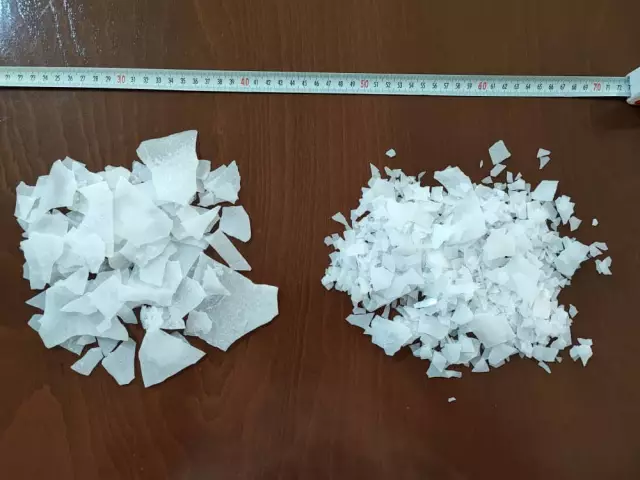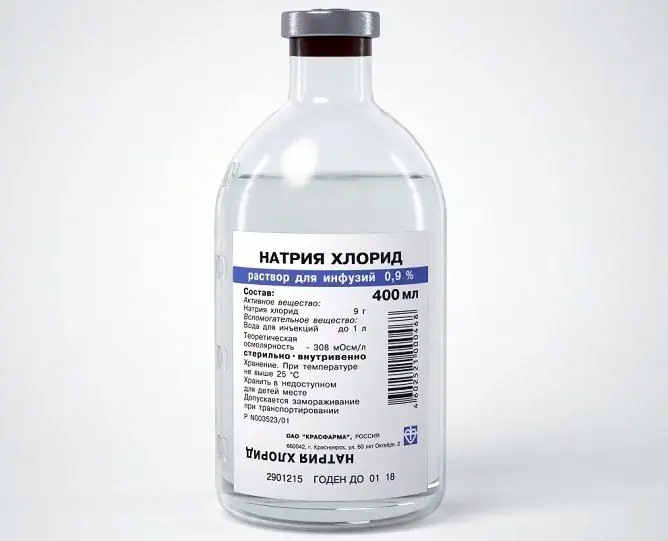- Author Rachel Wainwright [email protected].
- Public 2023-12-15 07:39.
- Last modified 2025-11-02 20:14.
Suxamethonium chloride
Suxamethonium chloride: instructions for use and reviews
- 1. Release form and composition
- 2. Pharmacological properties
- 3. Indications for use
- 4. Contraindications
- 5. Method of application and dosage
- 6. Side effects
- 7. Overdose
- 8. Special instructions
- 9. Application during pregnancy and lactation
- 10. Use in childhood
- 11. In case of impaired renal function
- 12. For violations of liver function
- 13. Drug interactions
- 14. Analogs
- 15. Terms and conditions of storage
- 16. Terms of dispensing from pharmacies
- 17. Reviews
- 18. Price in pharmacies
Latin name: Suxamethonium chloride
ATX code: M03AB01
Active ingredient: Suxamethonium chloride (Suxamethonium chloride)
Manufacturer: JSC Sintez (Russia)
Description and photo update: 2020-16-01

Suxamethonium chloride is a depolarizing muscle relaxant of peripheral action, a choline derivative.
Release form and composition
The drug is produced in the form of a solution for intravenous (i / v) and intramuscular (i / m) administration: transparent or slightly opalescent colorless liquid, may have a yellow tint [5 ml each in ampoules of colorless / neutral light-shielding glass, ampoules can be equipped with a break ring or by notch and dot: in cartons of 10 ampoules; in blisters of 5 ampoules, in a cardboard box 1 or 2 packages; in blister packs of 10 ampoules, in a cardboard box 1 pack. For ampoules without a break ring or a notch and a point, an ampoule scarifier is put into a cardboard box / pack. Each pack also contains instructions for the use of Suxamethonium chloride].
1 ml of solution contains:
- active substance: suxamethonium chloride - 20 mg;
- auxiliary components: sodium chloride, disodium edetate [ethylenediaminetetraacetic acid disodium salt (Trilon B)], water for injection.
Pharmacological properties
Pharmacodynamics
Suxamethonium chloride is a short-acting depolarizing muscle relaxant that blocks neuromuscular transmission. As a result of stimulation of n-cholinergic receptors by the active substance, depolarization of the end plate occurs. The spread of the process to the adjacent membranes causes a generalized disorganized contraction of myofibrils. Short-term relief of neuromuscular transmission is accompanied by muscle twitching preceding the development of the blockade. Remaining depolarized, the membranes do not respond to additional impulses. Spastic paralysis occurs, since to maintain muscle tone, it is necessary to receive repeated impulses associated with repolarization of the end plate. Muscle relaxation after intravenous injection proceeds in the following sequence: muscles of the eyelids, chewing muscles, muscles of fingers, eyes, limbs,neck, back and abdomen, vocal cords, then intercostal muscles and diaphragm.
The use of the drug under general anesthesia increases cerebral blood flow and intracranial pressure.
After intravenous administration of Suxamethonium chloride begins to act in 1 minute, after intramuscular administration - after 2-4 minutes. Maximum muscle relaxation with intravenous injection is achieved in 2-3 minutes and is fully maintained for 3 minutes. The total duration of muscle relaxation is 5-10 minutes.
The amount of the administered dose affects the severity of the drug action. So for relaxation of skeletal muscles without significant impact on the respiratory muscles, a dose is required, obtained at the rate of 0.1 mg per 1 kg of body weight (mg / kg) of the patient. For complete relaxation of the respiratory muscles with a complete stop or significant limitation of spontaneous breathing and muscles of the abdominal wall - 0.2-1 mg / kg. If long-term muscle relaxation is required, the required dose is re-administered. The use of the drug allows you to create a controlled and controlled muscle relaxation due to the rapid onset of the effect and the subsequent rapid restoration of muscle tone.
Pharmacokinetics
After intravenous administration of Suxamethonium chloride, it is distributed in the plasma and extracellular fluid. Cholinesterase in the blood hydrolyzes more than 90% of the administered dose to succinic acid and cholim.
At a normal level of cholinesterase concentration, the half-life is 1.5 minutes. It is excreted through the kidneys, including in unchanged form - 10%. It does not accumulate in the body.
Does not cross the intact blood-brain barrier.
Indications for use
The use of Suxamethonium chloride is indicated for the following interventions and conditions requiring short-term muscle relaxation:
- intratracheal intubation, bronchoscopy - to turn off spontaneous breathing;
- endoscopy, gynecological, thoracic or abdominal surgery, reduction of dislocations, reduction of fractures - for the purpose of complete muscle relaxation;
- symptomatic therapy for tetanus, strychnine poisoning;
- electrical impulse therapy - to prevent seizures.
Contraindications
Absolute:
- malignant hyperthermia (including history);
- acute liver failure;
- cholinesterase deficiency;
- myasthenia gravis, congenital / dystrophic myotonia, DMD (Duchenne muscular dystrophy;
- bronchial asthma, pulmonary edema;
- hyperkalemia;
- penetrating eye injuries, angle-closure glaucoma;
- period of pregnancy and lactation;
- age up to 1 year;
- hypersensitivity to drug components.
It is recommended to use Suxamethonium chloride with caution during emergency surgery in patients with a full stomach, decreased serum cholinesterase activity (end-stage liver failure), prolonged fasting, anemia, cachexia, chronic infections, trauma, tetanus, common burns, malignant neoplasms, tuberculosis, chronic renal insufficiency, systemic connective tissue diseases, myxedema, plasmapheresis, conditions after plasma transfusion, operations under extracorporeal circulation, acute or chronic intoxication with insecticides [cholinesterase inhibitors (if ingested), anticholinesterase drugs - ecothiopate iodide, neotidostigmine methylsimine, concomitant therapy with procaine (i.v.) and other means,competitors of Suxamethonium chloride for cholinesterase, as well as in the postpartum period.
Suxamethonium chloride, instructions for use: method and dosage
The use of Suxamethonium chloride is indicated against the background of general anesthesia only in specialized departments equipped with apparatus for artificial ventilation of the lungs and in the presence of personnel who possess this technique.
The solution is intended for intravenous and intramuscular administration.
In / in the drug is injected jet (slowly) or drip.
For long-term infusion, use a 0.1% solution of the drug. To obtain such a concentration, the required dose of Suxamethonium chloride is dissolved in 0.9% sodium chloride solution, Ringer's solution, 5% fructose solution or 6% dextran solution.
A single dose and route of administration depends on the clinical situation and may be:
- IV administration: in adults - from 0.1 to 1.5-2 mg / kg; in children - 1-2 mg / kg;
- i / m introduction: in adults - 3-4 mg / kg, in children - no more than 2.5 mg / kg. The maximum dose is 150 mg.
Recommended dosage per 1 kg of patient weight:
- endoscopy, electroencephalography: 0.2 mg / kg;
- muscle relaxation and interruption of spontaneous breathing: from 0.2 to 1 mg / kg;
- tracheal intubation: 0.2-0.8 mg / kg;
- relaxation of skeletal muscles during the reduction of dislocations and reposition of bone fragments in fractures: 0.1-0.2 mg / kg;
- prevention of complications (convulsions, detachment of muscles or tendons) during electroimpulse therapy: the drug is previously administered intramuscularly at a dose of 2.5 mg / kg, during the procedure - intravenously at 0.1-1 mg / kg.
Long-term relaxation of the muscles throughout the operation is achieved by fractional administration of the drug at a dose of 0.5-1 mg / kg with an interval of 5-7 minutes. For repeated doses, a more prolonged effect is characteristic.
Side effects
- from the immune system: allergic reactions in the form of anaphylactic shock, bronchospasm;
- on the part of the cardiovascular system: lowering blood pressure (BP), hyperkalemia, arrhythmias, conduction disturbances, bradycardia (especially often in children, with repeated administration in adults and children), cardiogenic shock;
- from the respiratory system: prolonged paralysis of the respiratory muscles;
- from the musculoskeletal system: myalgia (in the postoperative period); rarely - rhabdomyolysis, accompanied by the development of myoglobinuria and myoglobinemia;
- others: hypersalivation, fever, increased intraocular pressure.
Overdose
A symptom of an overdose of Suxamethonium chloride is respiratory arrest.
In this case, the patient needs to connect a ventilator. With a decrease in serum cholinesterase, fresh blood transfusion is performed.
special instructions
In order to prevent muscle twitching and subsequent myalgia, it is recommended to use non-depolarizing muscle relaxants 1 minute before the administration of Suxamethonium chloride.
For prolonged relaxation of the muscles, the use of non-depolarizing muscle relaxants is shown against the background of Suxamethonium chloride, which is previously administered for tracheal intubation. However, if necessary, the drug can be used for longer operations with repeated administration at an appropriate dose.
Before the administration of Suxamethonium chloride, the patient should be injected with atropine to prevent the effects caused by the stimulation of m-cholinergic receptors (including severe bradycardia, increased bronchial secretion).
The cause of a prolonged decrease in skeletal muscle tone with possible respiratory arrest (apnea) may be atypical serum cholinesterase, hereditary serum cholinesterase deficiency, or a temporary decrease in its concentration. It should be borne in mind that a temporary decrease in serum cholinesterase in a patient may be due to dehydration, febrile conditions, severe liver disease, severe anemia, exhaustion on the background of prolonged fasting, cachexia, acute poisoning or chronic ingestion of insecticides (cholinesterase inhibitors) or anticholinesterase therapy, concomitant procaine (i.v.) or other drugs that compete with Suxamethonium chloride for cholinesterase.
To eliminate the double neuromuscular block (prolonged curariform action), which has arisen against the background of prolonged administration of the drug at a dose of 3 to 5 mg / kg of body weight, neostigmine methyl sulfate can be used.
Influence on the ability to drive vehicles and complex mechanisms
After the cessation of the action of Suxamethonium chloride during the first 24 hours, patients are not recommended to engage in potentially hazardous activities, the implementation of which requires an increased concentration of attention and speed of psychomotor reactions, including driving and complex mechanisms.
Application during pregnancy and lactation
The use of Suxamethonium chloride during pregnancy and breastfeeding is contraindicated.
A muscle relaxant should be administered with caution in the postpartum period.
Pediatric use
The use of Suxamethonium chloride in children under 1 year of age is contraindicated.
With impaired renal function
In case of renal failure (if there are no signs of hyperkalemia or neuropathy) Suxamethonium chloride is administered only in medium doses and once, due to the risk of hyperkalemia as a result of repeated injections or when using higher doses.
Suxamethonium chloride should be used with caution in CRF (chronic renal failure).
For violations of liver function
The use of Suxamethonium chloride is contraindicated in acute liver failure.
The drug should be administered with caution to patients with end-stage hepatic failure.
Drug interactions
With simultaneous use with Suxamethonium chloride:
- cardiac glycosides: their therapeutic effect is enhanced;
- drugs for the treatment of myasthenia gravis: their effectiveness decreases;
- anticholinesterase agents, lidocaine, procaine, procainamide, verapamil, magnesium and lithium salts, beta-blockers, aminoglycoside antibiotics, propanidide, clindamycin, cyclopropane, amphotericin B, quinine, chloroquine, quinidine, each of the pancreatic organophosphates, the listed agents enhances and lengthens the muscle relaxant effect of the drug;
- other muscle relaxants, narcotic analgesics: no interaction with these drugs is observed;
- halogenated agents for general anesthesia: their undesirable effect on the cardiovascular system is enhanced;
- sodium thiopental, atropine: these drugs help to reduce the negative effect on the cardiovascular system;
- aprotinin, diphenhydramine, oxytocin, promethazine, glucocorticosteroids (in high doses), estrogens, oral contraceptives: against the background of concomitant therapy with each of the listed or other drugs with the potential ability to reduce cholinesterase activity in the blood, the effect of Suxamethonium chloride increases and lengthens.
The solution is pharmaceutically incompatible with blood preparations, blood preservatives, donor blood, serum preservatives, barbiturate solutions and alkaline solutions.
Analogs
The analogues of Suxamethonium chloride are: Listenone, Suxamethonium iodide, Suxamethonium bromide, Myo-relaxin, Anectin, Brevidil M, Chlorsuccillin, Ditilin-A, etc.
Terms and conditions of storage
Keep out of the reach of children.
Store at 2-8 ° C in a dark place.
The shelf life is 3 years.
Terms of dispensing from pharmacies
Dispensed by prescription.
Reviews about Suxamethonium chloride
The solution is used for local anesthesia, most often in combination with other pain relievers. Manipulations are carried out only by personnel who are familiar with the technique of administering muscle relaxants. Given these features of the use of the drug, patients do not leave feedback on Suxamethonium chloride, since they cannot subsequently assess its effectiveness.
Price for Suxamethonium chloride in pharmacies
The price for Suxamethonium chloride has not been established due to the lack of the drug in the pharmacy chain. The cost of a pharmaceutically equivalent muscle relaxant, Listenone, 20 mg / ml, per package containing 5 ampoules of 5 ml, varies from 128 to 134 rubles.

Maria Kulkes Medical journalist About the author
Education: First Moscow State Medical University named after I. M. Sechenov, specialty "General Medicine".
Information about the drug is generalized, provided for informational purposes only and does not replace the official instructions. Self-medication is hazardous to health!






